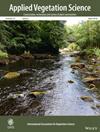Classification and Characterization of Anthropogenic Plant Communities in the Northwestern Iberian Peninsula
Abstract
Questions
Can we reconcile regional and European classifications of anthropogenic plant communities at the biogeographical scale? How are these communities characterized by species origins, traits and ecological preferences?
Location
Atlantic territories in the NW Iberian Peninsula (a.k.a. Cantabrian Mixed Forests ecoregion); south-western Europe.
Methods
We classified 2508 plots with the aim of being consistent with regional phytosociological expertise, while matching that expertise with current EuroVegChecklist alliances. We used modified TWINSPAN to revise the original phytosociological classification, followed by semi-supervised re-classification of the whole dataset. We determined the proportion of natives, archaeophytes, and neophytes. We also described the alliances in terms of species traits (lifeforms, height, and flowering phenology) and ecological requirements (temperature, moisture, light, nutrients, soil reaction, disturbance frequency, and severity).
Results
We assigned 2086 vegetation plots to 25 anthropogenic alliances representing nine vegetation classes (Cymbalario-Parietarietea diffusae, Polygono-Poetea annuae, Papaveretea rhoeadis, Digitario sanguinalis-Eragrostietea minoris, Chenopodietea, Sisymbrietea, Bidentetea, Artemisietea vulgaris, and Epilobietea angustifolii). The plots included 1149 species: 78% natives, 15% archaeophytes and 7% neophytes. Vegetation groups were organized along a principal axis of abiotic stress (dry-sunny to moist-shady habitats) and a secondary axis of disturbance.
Conclusions
In the Iberian Atlantic territories, anthropogenic habitats host one third of the regional plant species pool and one fifth of the Iberian flora. Mesic perennial ruderal vegetation is especially rich in native species and can be a biodiversity asset in urban landscapes. Our biogeographical-level synthesis can improve the management of anthropogenic plant communities and contribute towards a European-level synthesis of human-made vegetation.


 求助内容:
求助内容: 应助结果提醒方式:
应助结果提醒方式:


